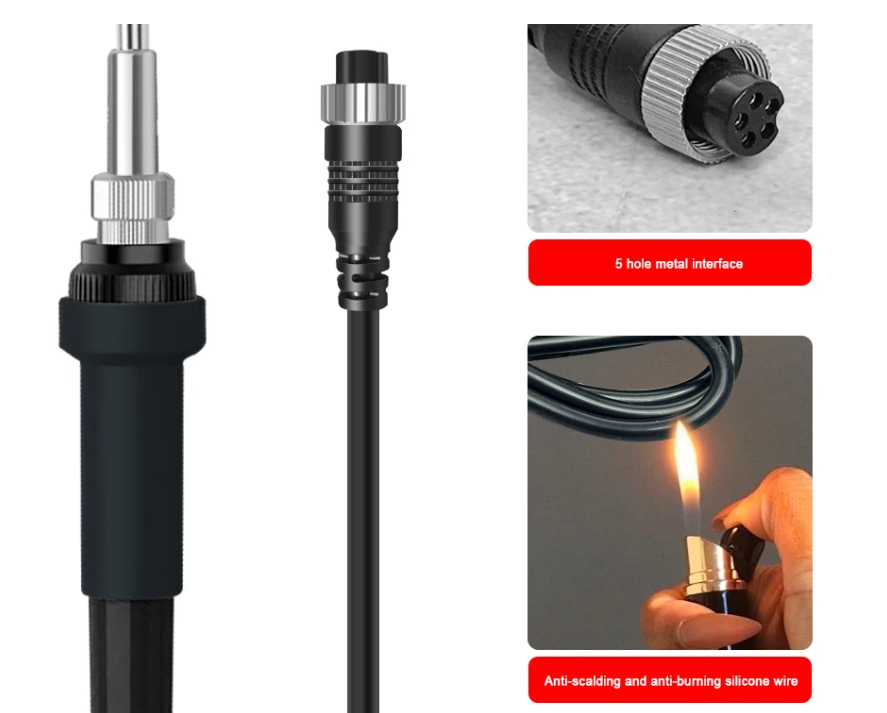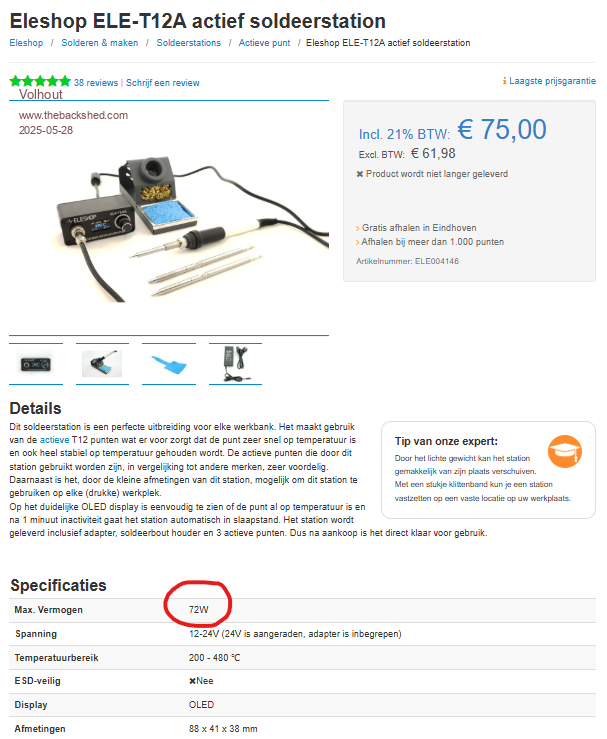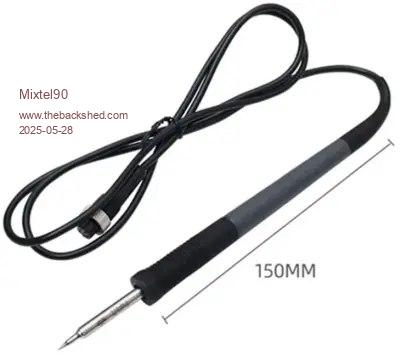
|

|
Forum Index : Microcontroller and PC projects : olimex
| Author | Message | ||||
| Volhout Guru Joined: 05/03/2018 Location: NetherlandsPosts: 5543 |
In my experience (I do solder a lot) an average of 8 watt may be sufficient. But in practise I allways grab the soldering station of 60-80 watt. Sometimes you need the power to heat up a larger component. This is also true for SMD. The SOT23's you can do with 8 watt (solder and de-solder), but SOT 223 will be hard, and D-PAK is impossible. Volhout Edited 2025-05-28 16:24 by Volhout PicomiteVGA PETSCII ROBOTS |
||||
| Mixtel90 Guru Joined: 05/10/2019 Location: United KingdomPosts: 8376 |
I've fallen in love with the T12 system now. I don't think I can go back. One iron does just about everything from tiny SMD upwards (I've not got any D-PAK to try, I don't think...), although it helps to change to a different tip sometimes. :) I'd recommend one, even the cheapest, to anyone including beginners. The thing is, they are upgradable to suit your style of working. For a beginner I'd suggest getting the most basic LCD display version (they have more facilities than the LED display versions). Get the tips from a better make such as Quicko - they are better quality. If you want a nicer handle I prefer the very slim version with the tapered cord grip. There's no screw-on clamp on these, the tips just plug in. If you find the handle too chunky just swap it for a different one. Pick the tip sizes and shapes that suit you - there are loads. You can get controllers with a built in power supply or with no power supply (you can use a 3A 19V laptop charger) or to plug onto a Makita-style battery. Mick Zilog Inside! nascom.info for Nascom & Gemini Preliminary MMBasic docs & my PCB designs |
||||
| PhenixRising Guru Joined: 07/11/2023 Location: United KingdomPosts: 1683 |
Good call, Mick  It took some searching regarding the type of cable but I found where it states "silicon", so how is it really, nice and soft?  |
||||
| Mixtel90 Guru Joined: 05/10/2019 Location: United KingdomPosts: 8376 |
Yes, it's quite good on the cheap lead supplied with the kit, but the slimline handle has even nicer cable. It's very soft and flexible - both are far better than even my old Antex 15W, which wasn't bad. -- I've just worked out a little design a teensy bit over 50mm square: DVI video 12-bit digital audio (I2C DAC) Micro SD card 11 accessible and uncommitted contiguous digital GPIO pins A 12th pin is wired to a pad, the idea being to use it to drive a WS2812B stuck on top of the SD card socket. :) Some of the pins are arranged to allow a mini RTC to be simply plugged in if required. A separate 2-pin connector is connected to 5V and GND. This can be used for input or output. (5V supply is to VSYS so USB port is protected) Total cost (without the Pico 2) should be less than £19 as I've not picked the cheapest sources. That's assuming that you don't have a "bits" collection. I've allowed £1 for the PCB, but you'd have to get 5. IMHO, even at this price, it makes the Olimex board expensive as it corrects several problems. If you have some of the components and you don't mind shopping on AE and "having a coupe left over" then you could possibly build this for not much more than £10. It's also designed to be easy to build (providing you fit the components in a sensible order!). The only SMD part is a reset button, but it will work fine without that. There wasn't enough room for a through-hole part! If I hadn't been stubborn about the size I could have fitted one no problem. :) Mick Zilog Inside! nascom.info for Nascom & Gemini Preliminary MMBasic docs & my PCB designs |
||||
| Volhout Guru Joined: 05/03/2018 Location: NetherlandsPosts: 5543 |
Confirmed....  Volhout . PicomiteVGA PETSCII ROBOTS |
||||
| Mixtel90 Guru Joined: 05/10/2019 Location: United KingdomPosts: 8376 |
Oops... There are 11 GPIO pins, but it's GP10 (the highest one) that is also connected to the pad for a WS2812B. It's not a 12th pin. Also, the audio is SPI - not I2C and I'd forgotten its CS signal. :( This is the handle that I got as an extra. OSS T12-X:  Mick Zilog Inside! nascom.info for Nascom & Gemini Preliminary MMBasic docs & my PCB designs |
||||
| stanleyella Guru Joined: 25/06/2022 Location: United KingdomPosts: 2703 |
nostalgia, remember these? the Antex was expensive at the time but isolated so didn't zap semiconductors Mick- the problem with the desoldering iron is the mains leads touch the hot iron. won't dump but rewire safe. |
||||
| Mixtel90 Guru Joined: 05/10/2019 Location: United KingdomPosts: 8376 |
The problem with the desoldering iron is that it's bare metal and has 240V inside it. :) A RCD will fix that to some extent. If the lead is ordinary plastic then you could rewire it with silicone (yes, I do still type "silicon" now and again! I know what I mean...), but I wouldn't bother personally - I don't use one of those much. I still have my Antex and a Weller 820D! However, the tip on the latter is a bit of bent copper wire now. :) It's in a box somewhere, I've not seen it for some time. My Antex is on a switched mains plug with a neon. The switch shorts out a diode in series with the iron, so when the switch is open the iron temperature and neon drop to about half power (as the supply is half-wave rectified). With the switch closed you get full power and max brightness from the neon. It's handy being able to leave it on standby. . Edited 2025-05-29 02:04 by Mixtel90 Mick Zilog Inside! nascom.info for Nascom & Gemini Preliminary MMBasic docs & my PCB designs |
||||
| stanleyella Guru Joined: 25/06/2022 Location: United KingdomPosts: 2703 |
the house has rccb. this desolder is terrible wiring but tried once and it's better than separate iron and pump. my weller used metal coat hangers but you can't get them anymore. would a 300W light dimmer be useful for a soldering iron? |
||||
| Mixtel90 Guru Joined: 05/10/2019 Location: United KingdomPosts: 8376 |
It depends on the dimmer, but you won't damage anything by trying it. After all, an ordinary soldering iron is only a resistor just as a light bulb is. It's just a triac doing the switching. It might not be a good idea to attempt to "dim" some of the temperature controlled irons, but you wouldn't want to! Mick Zilog Inside! nascom.info for Nascom & Gemini Preliminary MMBasic docs & my PCB designs |
||||
| The Back Shed's forum code is written, and hosted, in Australia. | © JAQ Software 2025 |